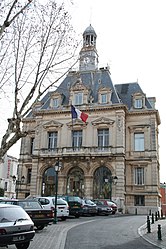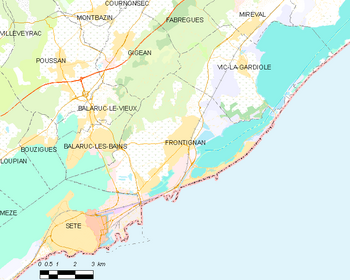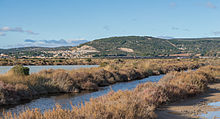Frontignan
Frontignan la Peyrade | |
|---|---|
 Town hall | |
| Coordinates: 43°26′54″N 3°45′22″E / 43.4483°N 3.7561°E | |
| Country | France |
| Region | Occitania |
| Department | Hérault |
| Arrondissement | Montpellier |
| Canton | Frontignan |
| Intercommunality | CA Sète Agglopôle Méditerranée |
| Government | |
| • Mayor (2020–2026) | Michel Arrouy[1] (PS) |
| Area 1 | 31.72 km2 (12.25 sq mi) |
| Population (2021)[2] | 23,808 |
| • Density | 750/km2 (1,900/sq mi) |
| Time zone | UTC+01:00 (CET) |
| • Summer (DST) | UTC+02:00 (CEST) |
| INSEE/Postal code | 34108 /34110 |
| Elevation | 0–223 m (0–732 ft) (avg. 2 m or 6.6 ft) |
| 1 French Land Register data, which excludes lakes, ponds, glaciers > 1 km2 (0.386 sq mi or 247 acres) and river estuaries. | |
Frontignan (French pronunciation: [fʁɔ̃tiɲɑ̃]; Occitan: Frontinhan) is a commune in the Hérault department in southern France.
Frontignan is renowned for its AOC wine, the Muscat de Frontignan, a sweet wine made solely from the Muscat grape variety.


Frontignan is located in the Languedoc coastal plain between the towns of Sète and Montpellier.
The town is surrounded by the Gardiole hills to the north, the Ingril lagoon in the east, the Étang de Thau to the west and the Mediterranean shore (including the beach resort Frontignan-Plage) to the south.
The Rhône-Sète canal separates the inland town centre and Frontignan-Plage. Frontignan station has rail connections (TER Occitanie) to Narbonne, Montpellier and Avignon.
In 1800, Frontignan was home to around 1400 individuals. Until the 20th century, Frontignan had a population of less than 4000. In 2007, there were over 23,000.
|
| ||||||||||||||||||||||||||||||||||||||||||||||||||||||||||||||||||||||||||||||||||||||||||||||||||||||||||||||||||
Graphs are unavailable due to technical issues. There is more info on Phabricator and on MediaWiki.org. | |||||||||||||||||||||||||||||||||||||||||||||||||||||||||||||||||||||||||||||||||||||||||||||||||||||||||||||||||||
| Source: EHESS[4] and INSEE (1968-2017)[5] | |||||||||||||||||||||||||||||||||||||||||||||||||||||||||||||||||||||||||||||||||||||||||||||||||||||||||||||||||||


Until the early 20th century the local economy was based on the production of marine salt and wine. Later petro-chemical and chemical industries predominate with a steady decline in the 1980s. The oil refinery that opened in 1900 was converted to a simple depot in 1986.
Since the end of the 20th century, modern fisheries and high-tech plastics take over. Seasonal tourism is a dominant part of the local economy.
Important businesses in Frontignan include:
Frontignan is twinned with: